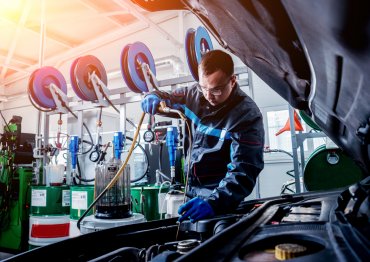
Sales by automotive oil change and lubrication shops in the United States are projected to grow by a compound annual rate of 4 percent from $6.1 billion in 2017 to $7.1 billion in 2021, according to a report jointly published by the Auto Care Association and the Automotive Aftermarket Suppliers Association.
The forecast includes sales histories and forecasts for a variety of automotive aftermarket categories. The report found that sales for all oil change and lubrication shops in the U.S. grew at a compound annual rate of 3.8 percent from $5.2 billion in 2013 to just shy of $6.1 billion in 2017.
Average sales per individual U.S. oil change and lubrication shop grew by a 3.7 percent compound annual rate from $683,722 in 2012 to $821,230 in 2017, the forecast concluded. The 2017 average was up 4.1 percent from $789,233 per shop in 2016.
Citing U.S. Bureau of Labor statistics, the forecast found the number of U.S. oil change and lubrication shops declined from 7,501 outlets in 2009 to 7,367 outlets in 2017.
Automotive oil change and lubrication shops are defined as establishments primarily engaged in changing motor oil and lubricating the chassis of automotive vehicles, under the North American Industry Classification System. The system is used for establishment-based federal economic statistics classified by industry for the United States, Mexico and Canada.
The forecast defines the U.S. motor vehicle aftermarket as including light vehicles, and medium- and heavy-duty trucks. The joint forecast model projects that consumer dollars spent in the overall U.S. motor vehicle aftermarket industry will grow at a 3.4 percent compound annual rate from $379 billion in 2017 to $433.3 billion in 2021. The aftermarket for light vehicles alone is also expected to grow at a 3.4 percent annual rate from $285.8 million in 2017 to $326.7 million in 2021.
Photo: Romaset/Shutterstock

It is expected this growth will be fueled by a gradually increasing number of miles driven, the increasing average age of vehicles and more specifically the growth of vehicle population in the 11-year [old] and older category, the Auto Care Association stated in its 2019 Factbook, which includes the joint channel forecast model results. Motorists recognize that vehicles are engineered to last longer and are therefore demonstrating a willingness to take advantage of the favorable economies of vehicle maintenance and repair versus the cost of purchasing new vehicles.
After growing almost 2.4 percent in both 2015 and 2016, total miles driven in the U.S. increased just 1.2 percent to 3.2 trillion miles in 2017. Continued strength in the employment market and rising consumer spending should get drivers moving again and help get miles driven growth back up over 2 percent for the year, the forecast stated.
Economic and market information firm IHS Markit conducted the market sizing and forecast on behalf of the two associations. The Aftermarket Size and Forecast Report is based on data from the U.S. Census Bureaus Economic Census, Industrial Marketing Research and proprietary IHS data, economic analysis and forecasting models.